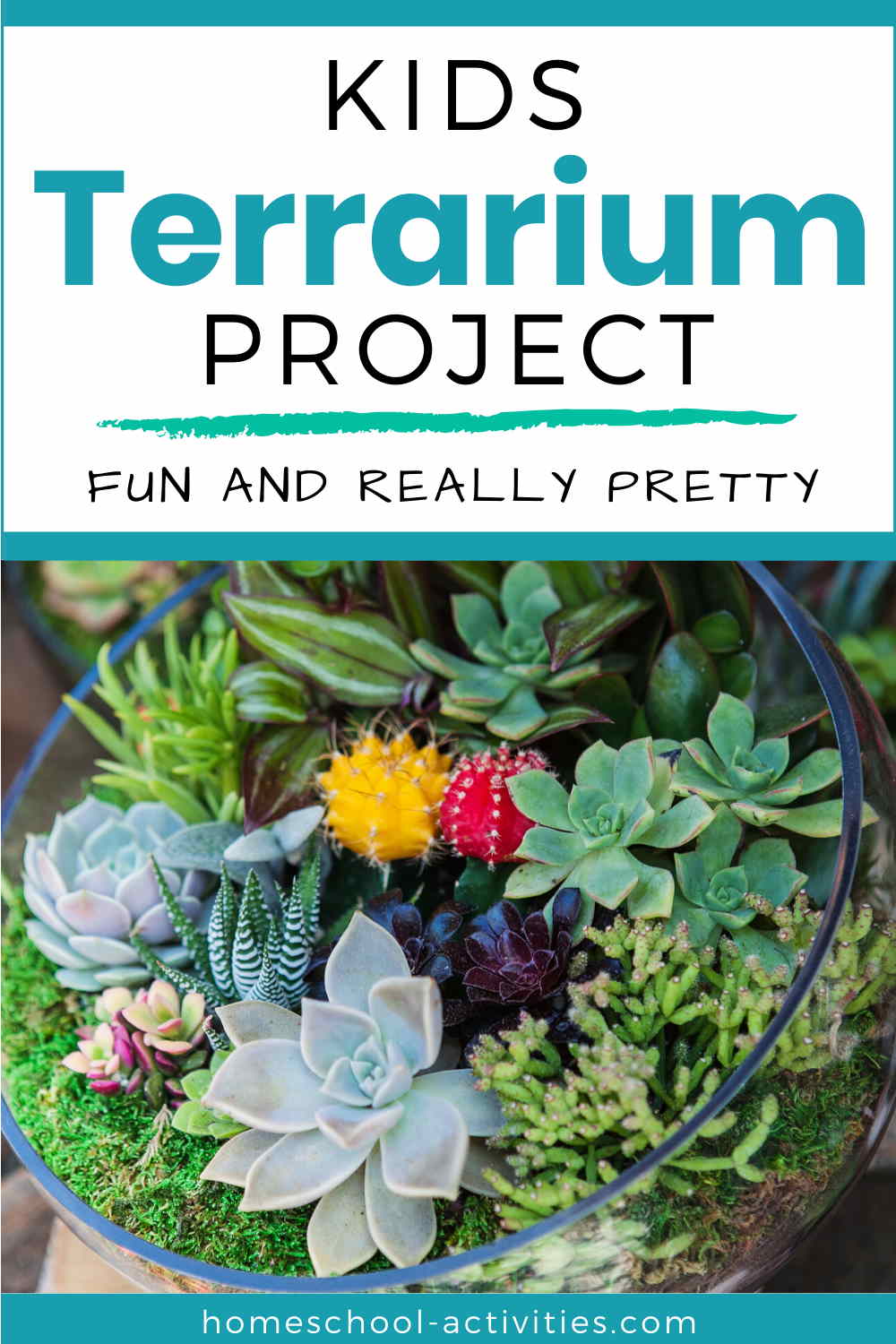How To Make A Terrarium With Kids:
Plant A Cactus Garden And Build A Container For Carnivorous Plants
Showing you how to make a terrarium is a delight, and you'll discover that it makes a perfect activity to share with kids.
You can see how to build a beautiful homeschool cactus terrarium for desert plants and we'll show you how to plant a carnivorous plant terrarium which even catches insects.
Growing a plant which eats definitely appeals to
kids!
Terrariums
are great for kids gardening because they're slug-less - which means
they're much more likely to succeed!
Building A Terrarium
- The first thing you need is a nice container. Because we were learning how to plant a homeschool cactus terrarium, my kids Catherine and William were happy to use a circular open-air dish, but you can choose pretty much whatever container you like - they all make great terrariums! Just make sure there are a few drainage holes in the bottom.
- If you want to make a bottle terrarium you'll need to adapt our homeschool instructions, because an enclosed space is harder to plant and care for.
- The first thing you need do is to cover the drainage holes with something so the water can drain out but your pebbles and soil don't fall through. You could build yours with some metal gauze covering the holes but we're into homeschool re-cycling and the kids used plastic netting bags (like the ones that come round fruit) instead.

- The next step in learning how to make a terrarium is to put a layer of pebbles or coarse sand in the bottom to help build up the drainage.
- Put a layer of soil on top. When we were building our homeschool cactus terrarium,
we bought some soil specially prepared for cactus plants, but regular
potting soil will do if you're thinking of trying to plant a different
sort of terrarium unless it's for carnivorous plants (see below).
- If you have gone for the harder option and chosen to build a bottle terrarium, you'll need to put a layer of activated charcoal
over the pebbles/sand layer which will keep the air fresh. This is the
type of charcoal used in aquarium filters so you can purchase it at any
pet shop with aquarium supplies.
- Add another layer of pebbles and build it up with a final layer of soil (either regular potting soil for a general terrarium, special cactus soil or the mixture below for carnivorous plants).

How To Plant A Terrarium

- Choosing the plants is the fun part of learning how to make a terrarium with kids!
- We found that garden centers have quite a restricted choice of plants and one of the delights of this fun homeschool activity is to get the kids researching on the internet where they can buy different plants and what conditions the plants need.
- Obviously, for a cactus terrarium, you want plants which all require the same position (full sun, for example).

- This is where homeschool science comes alive. Not only will your kids be watching and caring for something living which looks great, but they'll also learn all sorts of things about the adaptations cactus and desert plants make to survive. It's all part of making science fun.
- When choosing the plants, you want to go for variety. Tall, short, spiky, hairy, stony - that's the beauty of cactus! Your kids will have great fun deciding and when you're building your homeschool terrarium it will look much more appealing if there's a mix of cactus plants to look at.

Terrarium Planting
It's not just about the mix of plants you choose, it's also about planting the cactus in the right place.
An essential step in learning how to make a terrarium is to place your plants to best effect.
Tall ones often look best in the middle, and you could build down from there in height, ending up with a few short stone plants at the edges. You can add other ornaments to your terrarium planting.
A desert rose nodule would add some homeschool geology and look great among the cactus too.
You can find some care instructions and more planting hints at Martha Stewart.

Terrarium Tips
Once you've learned how to make a terrarium, your kids will need to know how to look after it. Here are some tips:
- Place your terrarium in direct sunlight every day.
- Water thoroughly every two weeks, allowing the water to drain away.
- Fertilize only in the summer (May through September.)
- Use half the fertilizer indicated in the box's instructions every other watering, which will be about once a month.
Build A Carnivorous Plant Terrarium

I'm sure it's not only my son William who loves carnivorous plants. They are fascinating for kids, and learning how to make a Venus Fly Trap Terrarium would be a fantastic way to add carnivorous plants to your homeschool rainforest activities.
You can learn how to make a terrarium for a Venus Fly Trap following the instructions above. They do well in a semi-enclosed terrarium because they like lots of humidity, but there are a couple of vital steps you need to take when building a terrarium for carnivorous plants:
-
Soil. Don't plant them in regular soil, they'll die.
Carnivorous plants need something with very few nutrients so go for a
half and half mixture of Perlite and Spaghnum Moss.
- Always water with rain water and always keep them moist. William leaves his in a tray of water.
- Feed carnivorous plants with animals and never fertiliser.
Sorry, but this does seem to be an attraction for kids! We use flies
in our homeschool, but crickets or ants are other yummy candidates.
- Don't stress your Venus Fly Trap by setting off its traps.
Other Easy Kids Activities
Keeping something living is always appealing to kids. William and Catherine loved looking after a pet from the age of the dinosaurs as you can see if you look at our Triops kit in our page on dinosaur activities.

Learning how to make a terrarium is easy and very satisfying. It's one of those great homeschool activities for kids because it brings science to life and makes it fun.
Love this page? Help me spread the word by sharing...
- Home
- Craft Ideas
- Terrarium
"Just had a look through your monthly
newsletter focusing on math. Thanks so much for all the links and
ideas. It's brilliant!" ~ Diana
"Hi....I totally love all your posts and enjoy reading them....the kids love the activities and enjoy them through and through." ~ Bianka

Free Newsletter

Must-have Handbook
4 books in one: Bargain discount deal!
"With the education system failing so many brilliant
children it's great to be able to have resources like your website for
inspiration, ideas and just a sense of belonging. What you are doing for
your children is priceless." ~ Natalija
"I really appreciate your time and effort that goes into your posts... It's nice to see that you are a 2nd generation homeschooler." ~ Teresa
"Your newsletters & book have helped us through our journey. For that I can only thank you.
Please, please, please keep it up, people like you make our home school life so much easier." ~ Kelly
"I have joined paid sites that were not even one percent as great as
this site. Really amazing what you are doing and so so helpful thanks so much!" ~ Eli










